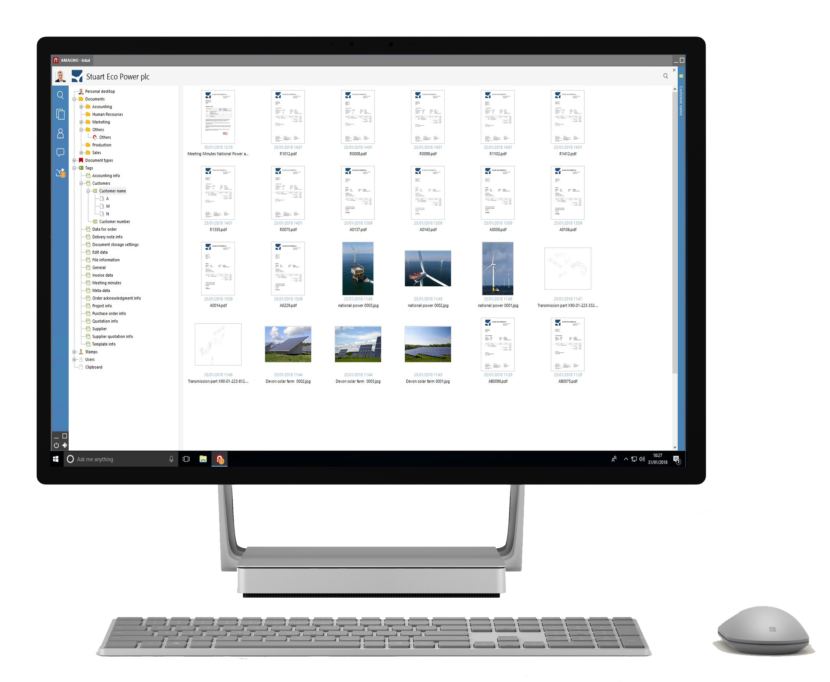Enterprise Content Management
What does ECM stand for?
Enterprise Content Management (ECM for short) refers to methods of compiling structured, unstructured or partially structured information.
ECM solutions bring together the various individual methods and technologies (gathering, managing, storing, retaining and providing) for managing files and documents, content in short. Content here refers to all physical (or analogue) and digital content in a company. Structured content can be, for example, invoices, contracts, quotations and personal folders. Partially structured content can include emails, other written correspondence and articles. Unstructured content – such as memos – is usually crucial for businesses but can often be difficult to retrieve in traditional paper trails.
An ECM solution allows you to define a strategy to deal with this “universe” of content within your company, everything to do with how documents are gathered, processed, managed and stored. The right ECM software maps the structures and processes as a company-wide solution. Using an Enterprise Content Management system brings lots of advantages and substantial cost savings for businesses.
A new generation of document management
FIND OUT MORE ABOUT AMAGNO DMS SOFTWARE
Document Management Solutions work! But don’t take our word for it: Download and Try AMAGNO for free. Then all you need to decide is whether you want AMAGNO as an In-House software solution (On-Premise) or if you prefer our AMAGNO Business Cloud.
START USING AMAGNO NOW
Download AMAGNO and connect to our Business Cloud for free. Download AMAGNO Now!
CHECK OUT OUR DMS SOFTWARE IN A WEBINAR
Check out a webinar and see how easy document management can be. Sign up now!
Gather and import documents
The first task is of course collecting all the content. Here, analogue receipts and invoices are also scanned and then filed in appropriate groups as digital documents. Documents that are already in digital form, such as electronic invoices via email, are also gathered and imported.
It is also possible to digitise large numbers of analogue documents and import them into an ECM system. These days, paper archives take up more and more space and are very laborious to navigate. With providers such as Dropscan, whole archives can be gathered digitally and archived in a cost-saving manner.
Manage and process files
Gathered files and documents are sorted into the suitable groups and are made accessible solely to those authorised with the authorisation system. Document management here includes the whole life cycle of a file and prevents accidental simultaneous editing by different people thanks to a check-out system to your personal desk.
Documents and files can be found by users thanks to a high-performance full text search. A key feature and also a big advantage of an ECM system for the user is that the documents you need are available to you in a matter of seconds.
Automation & workflow management
Automated business processes with a solid workflow management mean no longer having to send employees from room to room to print out invoices or quotations for release. Not even email is required here, because with an Enterprise Content Management solution this happens automatically and the employee sees which documents require attention and action in their list of tasks.
At the same time, an Enterprise Content Management system is not a closed system: it can be connected to other solutions via external interfaces (e.g. accounting systems, Sage, DATEV) and transfers data in order to make business processes as automated as possible.
Storage with Enterprise Content Management
With storage, the focus lies on short to mid-term retention of data and documents rather than archiving. Documents are no longer saved manually by users on network drives, but are automatically filed and organised via a client. Even if their are several versions of a document or file, there is still only one actual file made available to the user. This means that storage silos are dissolved and tedious searches in different network drive structures are eliminated.
The document needed can be called up either with a search function or via other attributes (e.g. click finder) in the ECM client. Here it doesn’t matter where a file is saved or how it is named – only what is inside it and which attributes or workflows are assigned to it.
Transferring and exporting data
Maintaining easy access to company data and documents in the form of Enterprise Content Management is becoming increasingly important. Files and documents have to be made available to employees outside of the traditional IT infrastructure if they are working from home or travelling. External partners, suppliers and tax advisors are also reliant on documents such as handbooks, delivery slips or bookkeeping receipts.
With ECM, documents are not sent as email attachments or even as print outs via post, but as password-protected links. Even non-employees and external persons can gain their own restricted access to the AMAGNO client, and CSV or XML data can be exported via external interfaces.
Archive and automatically keep to deadlines
The need for companies to invest in large rooms full of filing cabinets and boxes is a thing of the past. With Enterprise Content Management, your company generates and manages a digital archive in real time almost automatically. Unlike traditional data storage, the focus is not on long-term archiving. Existing analogue archives can be digitised and assigned keywords and can be structured practically automatically using OCR recognition.
Thanks to defined rules, as soon as you then create a new analogue or digital document, it is easy to determine whether it’s a new versioning of an existing file or whether it needs to be archived and put into long-term storage. ECM also allows companies to automatically set retention and deletion deadlines, giving you one less thing to think about in future.
Enterprise Content Management
Important pointers for selecting your ECM solution
The market for ECM solutions in Germany includes over 100 options, of which around 20 have a significant number of users. With over 9,000 users, AMAGNO is one of the most significant and extensive modern ECM/DMS solutions in Germany and has a solid customer base across a range of industries.
As a software provider, we daily discover that off the cuff searches for an ECM/DMS solution to combat file, receipt and email chaos generally end up being unsuccessful due to organisational reasons. Drawing on our experience, we would like to help you avoid the biggest mistakes and to give you the following tips.

Identify your main problem
You probably have one main problem which you are trying to solve. An ECM/DMS will help you on many levels. Inform yourself about further possibilities and ideas of an ECM/DMS solution before you pick up (choose/contact) the providers. First of all and ideally with the support of specialists, put together your company’s requirements specification document or at least an agreed list of needs and requirements for an ECM/DMS solution, so that you can methodically compare suppliers.
Get decision makers and users on board
Get all the decision makers (CEOs, controllers, finance department etc.) and future users involved. The introduction of an Enterprise Content Management system enables lots of new possibilities, savings and efficiency but also means a lot of changes for users. Powerful, modern, wide-reaching technologies often fail because of a low level of acceptance by users. Involving users early on to get them on board and to build familiarity lets you be sure that the new technology will be accepted.
Identifying investments and a project plan
Plan investments and the project schedule in order to identify and clear any stumbling blocks as soon as possible. A certain amount of investment is necessary at first in order to be able to enjoy the advantages later. This includes an investment of time and also money, but these will quickly pay off. If you’re not ready to do this, there is not much point in progressing any further. Create a chronological timescale that you will then follow along with the decision makers involved.
Put together a specification sheet early on
Especially interfaces and external applications should not be overlooked. Modern Enterprise Management systems are not closed solutions – they are highly integrative and communicate via corresponding interfaces with DATEV, for example, and with many other systems. All technical requirements should be laid out in a specification sheet. Ideally, such a requirement specification should be etablished at the very beginning and supplemented if necessary.



